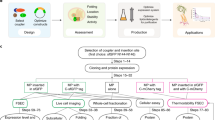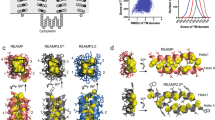Abstract
Chemical synthesis can produce membrane proteins bearing specifically designed modifications (e.g., phosphorylation, isotope labeling) that are difficult to obtain through recombinant protein expression approaches. The resulting homogeneously modified synthetic membrane proteins are valuable tools for many advanced biochemical and biophysical studies. This protocol describes the chemical synthesis of membrane proteins by condensation of transmembrane peptide segments through native chemical ligation. To avoid common problems encountered due to the poor solubility of transmembrane peptides in almost any solvent, we describe an effective procedure for the chemical synthesis of membrane proteins through the removable-backbone modification (RBM) strategy. Two key steps of this protocol are: (i) installation of solubilizing Arg4-tagged RBM groups into the transmembrane peptides at any primary amino acid through Fmoc (9-fluorenylmethyloxycarbonyl) solid-phase peptide synthesis and (ii) native ligation of the full-length sequence, followed by removal of the RBM tags by TFA (trifluoroacetic acid) cocktails to afford the native protein. The installation of RBM groups is achieved by using 4-methoxy-5-nitrosalicyladehyde by reduction amination to incorporate an activated O-to-N acyl transfer auxiliary. The Arg4-tag-modified membrane-spanning peptide segments behave like water-soluble peptides to facilitate their purification, ligation and mass characterization.
This is a preview of subscription content, access via your institution
Access options
Access Nature and 54 other Nature Portfolio journals
Get Nature+, our best-value online-access subscription
$29.99 / 30 days
cancel any time
Subscribe to this journal
Receive 12 print issues and online access
$259.00 per year
only $21.58 per issue
Buy this article
- Purchase on Springer Link
- Instant access to full article PDF
Prices may be subject to local taxes which are calculated during checkout




Similar content being viewed by others
References
Kent, S.B.H. Total chemical synthesis of proteins. Chem. Soc. Rev. 38, 338–351 (2009).
Huang, Y.C., Fang, G.M. & Liu, L. Chemical synthesis of proteins using hydrazide intermediates. Nat. Sci. Rev. 3, 107–116 (2016).
Bondalapati, S., Jbara, M. & Brik, A. Expanding the chemical toolbox for the synthesis of large and uniquely modified proteins. Nat. Chem. 8, 407–418 (2016).
Dawson, P.E., Muir, T.W., Clark-Lewis, I. & Kent, S.B.H. Synthesis of proteins by native chemical ligation. Science 266, 776–779 (1994).
Fang, G.M. et al. Protein chemical synthesis by ligation of peptide hydrazides. Angew. Chem. Int. Ed. Engl. 50, 7645–7649 (2011).
Wang, P. et al. Erythropoietin derived by chemical synthesis. Science 342, 1357–1360 (2013).
Gouaux, E. & Mackinnon, R. Principles of selective ion transport in channels and pumps. Science 310, 1461–1465 (2005).
Yildirim, M.A., Goh, K.I., Cusick, M.E., Barabási, A.L. & Vidal, M. Drug–target network. Nat. Biotech. 25, 1119–1126 (2007).
Lahiri, S., Brehs, M., Olschewski, D. & Becker, C.F. Total chemical synthesis of an integral membrane enzyme: diacylglycerol kinase from Escherichia coli. Angew. Chem. Int. Ed. Engl. 50, 3988–3992 (2011).
Valiyaveetil, F.I., MacKinnon, R. & Muir, T.W. Semisynthesis and folding of the potassium channel KcsA. J. Am. Chem. Soc. 124, 9113–9120 (2002).
Shen, F., Tang, S. & Liu, L. Hexafluoro-2-propanol as a potent cosolvent for chemical ligation of membrane proteins. Sci. China Chem. 54, 110–116 (2011).
Dittmann, M., Seidel, R., Chizhovb, I. & Engelhard, M. Total chemical synthesis of a membrane protein domain analogue containing two transmembrane helices: functional reconstitution of the semisynthetic sensory rhodopsin/transducer complex. J. Pept. Sci. 20, 137–144 (2014).
Sato, T., Saito, Y. & Aimoto, S. Synthesis of the C-terminal region of opioid receptor like 1 in an SDS micelle by the native chemical ligation: effect of thiol additive and SDS concentration on ligation efficiency. J. Pept. Sci. 11, 410–416 (2005).
Johnson, E.C.B. & Kent, S.B.H. Towards the total chemical synthesis of integral membrane proteins: a general method for the synthesis of hydrophobic peptide-α-thioester building blocks. Tetrahedron Lett. 48, 1795–1799 (2007).
Tan, Z., Shang, S. & Danishefsky, S.J. Rational development of a strategy for modifying the aggregatibility of proteins. Proc. Natl. Acad. Sci. USA 108, 4297–4302 (2011).
Huang, Y.C. et al. Synthesis of autophagosomal marker protein LC3-II under detergent-free conditions. Angew. Chem. Int. Ed. Engl. 52, 4858–4862 (2013).
Jacobsen, M.T. et al. A helping hand to overcome solubility challenges in chemical protein synthesis. J. Am. Chem. Soc. 138, 11775–11782 (2016).
Maity, S.K. et al. Palladium-assisted removal of a solubilizing tag from a Cys side chain to facilitate peptide and protein synthesis. Org. Lett. 18, 3026–3029 (2016).
Sohma, Y., Sasaki, M., Hayashi, Y., Kimura, T. & Kiso, Y. Novel and efficient synthesis of difficult sequence-containing peptides through O-N intramolecular acyl migration reaction of O-acyl isopeptides. Chem. Commun. 7, 124–125 (2004).
Dos Santos, S. et al. Switch-peptides: controlling self-assembly of amyloid beta-derived peptides in vitro by consecutive triggering of acyl migrations. J. Am. Chem. Soc. 127, 11888–11889 (2005).
Asahina, Y., Kamitori, S., Takao, T., Nishi, N. & Hojo, H. Chemoenzymatic synthesis of the immunoglobulin domain of Tim-3 carrying a complex-type N-glycan by using a one-pot ligation. Angew. Chem. Int. Ed. Engl. 52, 9733–9737 (2013).
Olschewski, D. & Becker, C.F. Chemical synthesis and semisynthesis of membrane proteins. Mol. Biosyst. 4, 733–740 (2008).
Shen, F., Huang, Y.C., Tang, S., Chen, Y.X. & Liu, L. Chemical synthesis of integral membrane proteins: methods and applications. Isr. J. Chem. 51, 940–952 (2011).
Zuo, C., Tang, S. & Zheng, J.S. Chemical synthesis and biophysical applications of membrane proteins. J. Pept. Sci. 21, 540–549 (2015).
Johnson, E.C.B. & Kent, S.B.H. Studies on the insolubility of a transmembrane peptide from signal peptide peptidase. J. Am. Chem. Soc. 128, 7140–7141 (2006).
Zheng, J.S. et al. Expedient total synthesis of small to medium-sized membrane proteins via Fmoc chemistry. J. Am. Chem. Soc. 136, 3695–3704 (2014).
Zheng, J.S. et al. Robust chemical synthesis of membrane proteins through a general method of removable backbone modification. J. Am. Chem. Soc. 138, 3553–3561 (2016).
Zuo, C. et al. Efficient synthesis of longer Aβ peptides via removable backbone modification. Org. Biomol. Chem. 14, 5012–5018 (2016).
Li, J.B., Tang, S., Zheng, J.S., Tian, C.L. & Liu, L. Removable backbone modification method for the chemical synthesis of membrane proteins. Acc. Chem. Res. 50, 1143–1153 (2017).
Paradis-Bas, M., Tulla-Puche, J. & Albericio, F. The road to the synthesis of 'difficult peptides'. Chem. Soc. Rev. 45, 631–654 (2016).
Albericio, F., Tulla-Puche, J. & Kates, S.A. Fmoc methodology: cleavage from the resin and final deprotection. In Amino Acids, Peptides and Proteins in Organic Chemistry Vol. 3 (ed Hughes, A.B.) 349–369 (WILEY-VCH, 2010).
Popot, J. Folding membrane proteins in vitro: a table and some comments. Arch. Biochem. Biophys. 564, 314–326 (2014).
Kochendoerfer, G.G. et al. Total chemical synthesis of the integral membrane protein influenza A virus M2: role of its C-terminal domain in tetramer assembly. Biochemistry 38, 11905–11913 (1999).
Zheng, J.S., Tang, S., Qi, Y.K., Wang, Z.P. & Liu, L. Chemical synthesis of proteins using peptide hydrazides as thioester surrogates. Nat. Protoc. 8, 2483–2495 (2013).
Stouffer, A.L. et al. Structural basis for the function and inhibition of an influenza virus proton channel. Nature 451, 596–599 (2008).
Kyte, J. & Doolittle, R.F. A simple method for displaying the hydropathic character of a protein. J. Mol. Biol. 157, 105–132 (1982).
Nieva, J.L., Madan, V. & Carrasco, L. Viroporins: structure and biological functions. Nat. Rev. Microbiol. 10, 563–574 (2012).
Coin, I., Beyermann, M. & Bienert, M. Solid-phase peptide synthesis: from standard procedures to the synthesis of difficult sequences. Nat. Protoc. 2, 3247–3256 (2007).
Acknowledgements
This study was supported by the National Key R&D Program of China (no. 2017YFA0505200) and the National Natural Science Foundation of China (grant nos. 21532004, 81621002, 21621003 and 21402206).
Author information
Authors and Affiliations
Contributions
L.L., J.-S.Z. and C.-L.T. conceived and led the project and wrote the manuscript. S.T., C.Z., C.-L.T., X.-Y.C., D.-L.H. and L.-H.Z. conducted the experiments.
Corresponding authors
Ethics declarations
Competing interests
The authors declare no competing financial interests.
Integrated supplementary information
Supplementary Figure 1 Synthesis of M2[1-49, A30, RBM]-NHNH2.
(a) RP-HPLC analysis of the crude peptide M2[1-49, A30, RBM-Ac]-NHNH2 1' running on a C4- column. The linear gradient for analytical HPLC: 5% buffer B in buffer A to 95% B in A over 30 min. (b) ESI-MS of 1'. (c) ESI-MS of M2[1-49, A30, RBM]-NHNH2 1. (c) RP-HPLC analysis of the purified peptide M2[1-49, A30, RBM]-NHNH2 1 running on a C4- column. The linear gradient for analytical HPLC: 5% buffer B in buffer A to 95% B in A over 30 min. (d) ESI-MS of 1.
Supplementary Figure 2 Synthesis of M2[50-97, pSer64] (2).
(a) RP-HPLC analysis of the crude peptide 2 running on a C4- column. The linear gradient for analytical HPLC: 5% buffer B in buffer A to 95% B in A over 30 min. (b) RP-HPLC analysis of the purified peptide 2 running on a C4-column. The linear gradient for analytical HPLC: 20% buffer B in buffer A for 10 min, and then 20% buffer B in buffer A to 95% B in A over 30 min. (c) ESI-MS of 2.
Supplementary Figure 3 ESI-MS of 1′′ and 3.
(a) ESI-MS of 1”. (b) ESI-MS of 3.
Supplementary Figure 4 ESI-MS of 4.
Insert figure caption here by deleting or overwriting this text; captions may run to a second page if necessary.
Supplementary Figure 5 Synthesis of M2-TM(22-46).
(a) ESI-MS of M2-TM(22-46,RBM-Ac). (b) RP-HPLC analysis of the crude peptide of M2-TM(22-46,RBM) running on a C4- column. (c) RP-HPLC analysis of the purified peptide M2-TM(22-46,RBM) running on a C4-column. The linear gradient for analytical HPLC: 20% buffer B in buffer A for 10 min, and then 20% buffer B in buffer A to 95% B in A over 30 min. (d) ESI-MS of M2-TM(22-46,RBM). (e) RP-HPLC analysis of the purified peptide M2-TM(22-46) running on a C4-column. The linear gradient for analytical HPLC: 20% buffer B in buffer A to 95% B in A over 30 min. (f) ESI-MS of M2-TM(22-46).
Supplementary Figure 6 Synthesis of native M2.
(a) RP-HPLC analysis of native M2 running on a C4-column. The linear gradient for analytical HPLC: 40% buffer B in buffer A to 95% B in A over 30 min. (b) ESI-MS of native M2.
Supplementary Figure 7 Circular dichroism spectroscopy of purified M2, M2-TM(22-46) and M2-pSer64.
~10 μM of M2, M2-TM(22-46) or M2-pSer64 in 20 mM Tris, 50 mM OG,50 mM NaCl (pH 7.3) is analyzed in a 1 mm quartz cell.
Supplementary Figure 8 M2-pSer64-liposome-based fluorescent dye permeability assay.
Small light yellow circles represent 5(6)-carboxyfluorescein (CF) at self-quenching concentrations, and the small dark yellow circles represent CF being released from the liposomes (large black circles) after the addition of M2-pSer64, M2, and M2-TM (22-46). 0.5% Triton-X 100 was used to break the liposome and completely released the CF. The background fluorescence was measured with 2.5 % TFE added to liposome suspension.
Supplementary information
Supplementary Text and Figures
Supplementary Figures 1–8. (PDF 1408 kb)
Rights and permissions
About this article
Cite this article
Tang, S., Zuo, C., Huang, DL. et al. Chemical synthesis of membrane proteins by the removable backbone modification method. Nat Protoc 12, 2554–2569 (2017). https://doi.org/10.1038/nprot.2017.129
Published:
Issue Date:
DOI: https://doi.org/10.1038/nprot.2017.129
This article is cited by
-
Recent advances in chemical protein synthesis: method developments and biological applications
Science China Chemistry (2024)
-
A bifunctional molecule-assisted synthesis of mimics for use in probing the ubiquitination system
Nature Protocols (2023)
-
Chemical Synthesis of Proteins Containing 300 Amino Acids
Chemical Research in Chinese Universities (2020)
-
Diselenide–selenoester ligation for chemical protein synthesis
Nature Protocols (2019)
-
Channel activity of mirror-image M2 proton channel of influenza A virus is blocked by achiral or chiral inhibitors
Protein & Cell (2019)
Comments
By submitting a comment you agree to abide by our Terms and Community Guidelines. If you find something abusive or that does not comply with our terms or guidelines please flag it as inappropriate.



